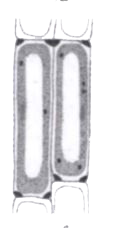Refer to the given diagrammatic represention of parts of two different types of tissues , P and Q.
Read the following statements regarding these tissues and select the correct statements .
(i)P is a plant whereas Q is an animal tissue.
(ii)P is the major water conducting tissue in vascular plants and provides mechanical strength to plant body.
(iii)Q is a specialised tissue in animals for receiving stimuli and transmitting messages .
(iv) P is composed of all dead cells whereas Q is composed of all living cells.
(i) and (ii) only
(iii) and (iv) only
(i) and (iii) only
(i),(iii) and (iv) only
The correct Answer is:C
To solve the question regarding the two types of tissues P and Q, we will analyze each statement provided and determine their correctness based on the characteristics of plant and animal tissues.
1. Identify Tissue P and Q:
- Tissue P is identified as a plant tissue, specifically the phloem, which is responsible for the transport of food in plants.
- Tissue Q is identified as an animal tissue, specifically a neuron, which is responsible for receiving stimuli and transmitting messages.
2. Evaluate Statement (i):
- "P is a plant whereas Q is an animal tissue."
- This statement is correct because P is indeed a plant tissue (phloem) and Q is an animal tissue (neuron).
3. Evaluate Statement (ii):
- "P is the major water conducting tissue in vascular plants and provides mechanical strength to the plant body."
- This statement is incorrect. The major water-conducting tissue in vascular plants is xylem, not phloem. Phloem primarily conducts food.
4. Evaluate Statement (iii):
- "Q is a specialized tissue in animals for receiving stimuli and transmitting messages."
- This statement is correct. Neurons (Q) are specialized for this function in animals.
5. Evaluate Statement (iv):
- "P is composed of all dead cells whereas Q is composed of all living cells."
- This statement is incorrect. While phloem does contain some living cells (like companion cells), it also has sieve tubes which are living but lack a nucleus. Thus, not all cells in P are dead.
Conclusion:
Based on the evaluations:
- Correct statements: (i) and (iii).
- Incorrect statements: (ii) and (iv).
Final Answer:
The correct statements regarding the tissues P and Q are:
- (i) P is a plant whereas Q is an animal tissue.
- (iii) Q is a specialized tissue in animals for receiving stimuli and transmitting messages.
- Tissue P is identified as a plant tissue, specifically the phloem, which is responsible for the transport of food in plants.
- Tissue Q is identified as an animal tissue, specifically a neuron, which is responsible for receiving stimuli and transmitting messages.
- "P is a plant whereas Q is an animal tissue."
- This statement is correct because P is indeed a plant tissue (phloem) and Q is an animal tissue (neuron).
- "P is the major water conducting tissue in vascular plants and provides mechanical strength to the plant body."
- This statement is incorrect. The major water-conducting tissue in vascular plants is xylem, not phloem. Phloem primarily conducts food.
- "Q is a specialized tissue in animals for receiving stimuli and transmitting messages."
- This statement is correct. Neurons (Q) are specialized for this function in animals.
- "P is composed of all dead cells whereas Q is composed of all living cells."
- This statement is incorrect. While phloem does contain some living cells (like companion cells), it also has sieve tubes which are living but lack a nucleus. Thus, not all cells in P are dead.
Based on the evaluations:
- Correct statements: (i) and (iii).
- Incorrect statements: (ii) and (iv).
The correct statements regarding the tissues P and Q are:
- (i) P is a plant whereas Q is an animal tissue.
- (iii) Q is a specialized tissue in animals for receiving stimuli and transmitting messages.
Topper's Solved these Questions
- NSO QUESTION PAPER 2019 SET BBOOK - SCIENCE OLYMPIAD FOUNDATION CHAPTER - NSO QUESTION PAPER 2019 SET BEXERCISE - ACHIEVERS SECTION
1 Videos
- NSO QUESTION PAPER 2019 SET ABOOK - SCIENCE OLYMPIAD FOUNDATION CHAPTER - NSO QUESTION PAPER 2019 SET AEXERCISE - ACHIEVERS SECTION
2 Videos
- NSO QUESTION PAPER 2020 SET 1BOOK - SCIENCE OLYMPIAD FOUNDATION CHAPTER - NSO QUESTION PAPER 2020 SET 1EXERCISE - ACHIEVERS SECTION
1 Videos
Similar Questions
Knowledge Check
Which tissue provides mechanical strength to plants?
ASclerenchymaBparenchymaCCollenchymaDchlorenchymaThe conducting tissues of the plants are
ASclerenchymaBPhloemCXylemDXylem and phloem bothWhich of the following plant tissue provide mechanical strength to plants?
AParenchymaBCollenchymaCSclerenchymaDAerenchyma
Write down name of different types of plant tissues.
View SolutionHow are plant and animal tissue different ?
View SolutionWhich plant tissue provides both mechanical strength as well as flexibility ?
View SolutionWhich one of the following statements about meristematic tissues in plants is correct ?
View SolutionRefer to the given figure showing section of a plant tissue and select the correct statement regarding it.

View Solution
